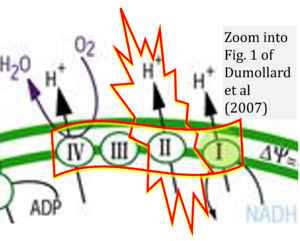Dumollard 2007 Development
| Dumollard R, Ward Z, Carroll J, Duchen MR (2007) Regulation of redox metabolism in the mouse oocyte and embryo. Development 134:455-65. https://doi.org/10.1242/dev.02744 |
Dumollard R, Ward Z, Carroll J, Duchen MR (2007) Development
Abstract: Energy homeostasis of the oocyte is a crucial determinant of fertility. Following ovulation, the oocyte is exposed to the unique environment of the Fallopian tube, and this is reflected in a highly specialised biochemistry. The minute amounts of tissue available have made the physiological analysis of oocyte intermediary metabolism almost impossible. We have therefore used confocal imaging of mitochondrial and cytosolic redox state under a range of conditions to explore the oxidative metabolism of intermediary substrates. It has been known for some time that the early mouse embryo metabolises external pyruvate and lactate but not glucose to produce ATP. We now show at the level of single oocytes, that supplied glucose has no effect on the redox potential of the oocyte. Pyruvate is a cytosolic oxidant but a mitochondrial reductant, while lactate is a strong cytosolic reductant via the activity of lactate dehydrogenase. Unexpectedly, lactate-derived pyruvate appears to be diverted from mitochondrial oxidation. Our approach also reveals that the level of reduced glutathione (GSH) in the oocyte is maintained by glutathione reductase, which oxidises intracellular NADPH to reduce oxidised glutathione. Surprisingly, NADPH does not seem to be supplied by the pentose phosphate pathway in the unfertilised oocyte but rather by cytosolic NADP-dependent isocitrate dehydrogenase. Remarkably, we also found that the oxidant action of pyruvate impairs development, demonstrating the fundamental importance of redox state on early development.
• Bioblast editor: Gnaiger E
Correction: FADH2 and Complex II
- FADH2 is shown as the substrate feeding electrons into Complex II (CII). This is wrong and requires correction - for details see Gnaiger (2024).
- Gnaiger E (2024) Complex II ambiguities ― FADH2 in the electron transfer system. J Biol Chem 300:105470. https://doi.org/10.1016/j.jbc.2023.105470 - »Bioblast link«
- CII is erroneously shown as a H+ pump.
- Gnaiger E (2024) Complex II ambiguities ― FADH2 in the electron transfer system. J Biol Chem 300:105470. https://doi.org/10.1016/j.jbc.2023.105470 - »Bioblast link«


